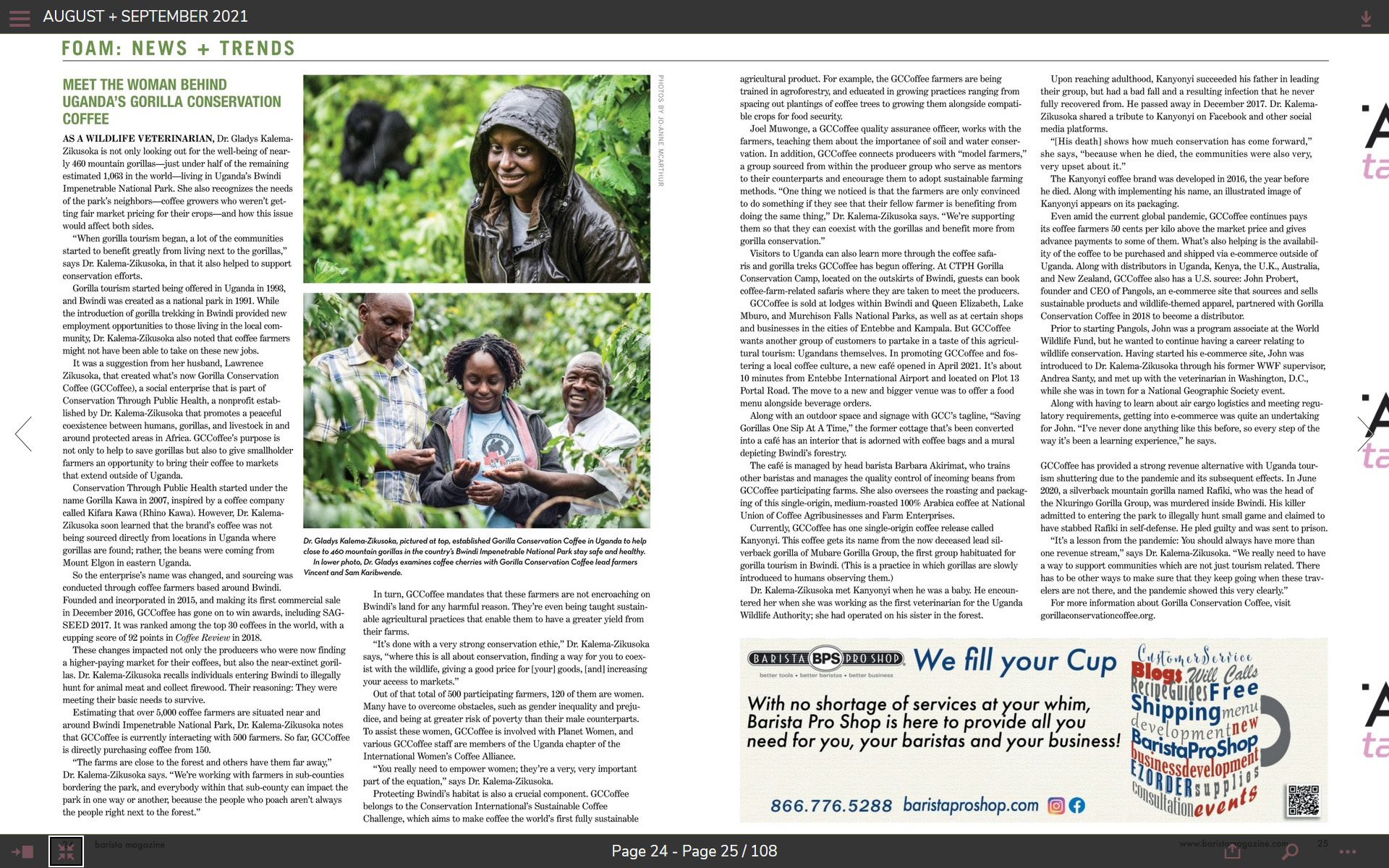
Click here or on “SOURCE” to read the article from the original website.
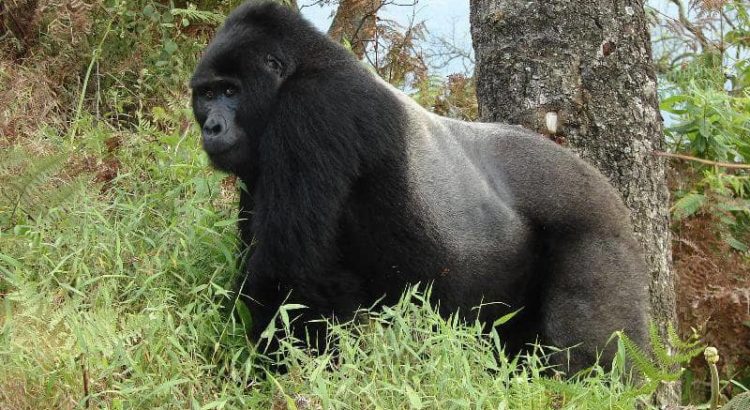
Ruhondeza, the gorilla that lives on in the hearts and minds of the Bwindi community
The Bwindi Impenetrable Forest is a national park in Uganda, an Important Bird & Biodiversity Area, and an Eastern Afromontane Key Biodiversity Area. The Critical Ecosystem Partnership Fund, through a small grant facilitated by BirdLife International, supports Conservation Through Public Health in their effort to reduce human-gorilla conflicts in and around the park, and avoid the transmission of diseases. This story describes how a potential drama turned into a unique friendship between local people and a legendary animal…
By Dr. Gladys Kalema-Zikusoka – Founder and CEO, Conservation Through Public Health (CTPH)
I have been working with mountain gorillas since 1994, when there were only two gorilla groups called Mubare and Katendegyere, habituated for tourism at Bwindi Impenetrable National Park. Now 25 years later, there are 17 gorilla groups habituated for tourism. Mubare gorilla group was headed by the silverback Ruhondeza, given that name because he liked “sleeping a lot”. Though Ruhondeza was smaller than the other silverbacks, he had the largest number of adult female gorillas to himself and was calmer than the Katendegyere gorilla group and therefore easier to habituate.
Katendegyere gorilla group eventually reduced in size, because there were too many males and only one female, and two years later the lead silverback, Mugurusi, meaning “old man” and named because he was very old when habituation began, eventually died of heart and kidney failure. I was called to check on Mugurusi when he could no longer keep up with the group and did a post-mortem on him a few days later. Fortunately, he did not have an infectious disease, however, a few months later his group developed scabies, a highly contagious skin disease more commonly known in animals as sarcoptic mange. This resulted in the death of the infant and sickness in the rest of the gorillas that only recovered after we gave Ivermectin anti parasitic treatments. The scabies was ultimately traced to people living around the national park who have inadequate access to basic health and other social services.

In 2012, Ruhondeza also became too old, and he eventually could not keep up with the rest of his group. The Mubare gorilla group left him in search of food and he decided to settle outside the Bwindi Impenetrable National Park in community land. When the Uganda Wildlife Authority (UWA) park management called Conservation Through Public Health (CTPH) to look into the possibility of translocating Ruhondeza back to the safety of the forest, we checked on him and saw that he was really settled and even if we moved him back, he would likely return to community land. We spoke to our Village Health and Conservation Teams (VHCTs), volunteers who liaise between CTPH and their community, about tolerating Ruhondeza in the village – particularly since his calm and accommodating nature had enabled gorilla tourism to begin in 1993, changing the lives and future for many people in the Bwindi community for ever. In the meeting the VHCTs assured us that even when their own elderly become very weak, they look after them, so why should this not apply to Ruhondeza as well?.
This resulted in Ruhondeza being accepted in the Bwindi community where they tolerated him eating banana plants or the occasional coffee berry. When the fateful day came and Ruhondeza was laid to rest, the Bwindi community members all came to pay their last respects to a legend. To this day he is remembered through the Ruhondeza village walk and other community experiences and also through his son, Kanyonyi, who took over the Mubare Gorilla Group after he died. CTPH named the first blend of our Gorilla Conservation Coffee after him.
Ruhondeza truly signifies how far conservation efforts have paid off in Bwindi, and that true friendship between people and wild animals is, indeed, possible.
Watch Dr. Gladys Kalema Zikusoka talk more about how CTPH is working with local farmers to reduce threats to Endangered mountain gorillas around Bwindi Impenetrable National Park KBA
BirdLife International runs the Regional Implementation Team (RIT) for the Critical Ecosystem Partnership Fund (CEPF) investment in the Eastern Afromontane Hotspot (2012 -2019). See the interactive map of all projects implemented under the CEPF Eastern Afromontane Hotspot programme here.
The Critical Ecosystem Partnership Fund is a joint initiative of l’Agence Française de Développement, Conservation International, the European Union, the Global Environment Facility, the Government of Japan and the World Bank. A fundamental goal is to ensure civil society is engaged in biodiversity conservation. More information on the CEPF can be found at www.cepf.net.

Poor communities in Bwindi national park have long depended on what the forest can provide. But with gorillas under threat, coffee now offers a more sustainable living.
Robert Byarugaba, now 45, began poaching with his father in Uganda’s Bwindi Impenetrable Forest at just eight years old.
“My dad would force me to follow him to go in the park because I was his only son,” Byarugaba says. “We poached and hunted from Monday to Sunday. Every day we would be in the forest.”
The father and son weren’t the only ones, there were many hunters who combed the forest for bushpigs, antelopes, goats, and sometimes gorillas. The great apes might be killed to feed local families, or their meat and body parts could fetch high sums on the market for bush meat or traditional medicine.
Read more: Dian Fossey: Gorilla researcher in the mist
Uganda is home to almost half of the world’s estimated 1,000 surviving mountain gorillas. In 1991, when the primates’ population fell to an estimated 300 animals, the Ugandan government made Bwindi a national park. That meant increased protection and regulation of access to the park. But many poachers continued to hunt all the same because their livelihoods depended on it.
Read more: Gorilla population in Africa rises
After five years, Byarugaba gave up poaching and began to grow coffee, but he couldn’t sell enough to make a living and supplemented his income taking tourists bird spotting in the forest.
Since 2017, that’s changed. Thanks to the work of Gorilla Conservation Coffee, Byarugaba says he now makes a reliable living from his coffee plantation. The social enterprise advises coffee growers and buys their crop, so they don’t have to resort to pillaging the forest.
Read more: The wilderness and the war
Making coffee profitable
The project was started by Gladys Kalema-Zikusoka. A wildlife veterinarian, she first came to Bwindi in 1994 and was struck by the poverty blighting villagers in the national park. Later, she founded the NGO Conservation Through Public Health (CTPH) to tackle disease transmission between humans and wildlife. Tracking gorillas through the forest, she would cross coffee farms. That got her thinking.
Read more: 10 facts you probably didn’t know about great apes
Not all coffee farmers were supplementing their meagre income with legal occupations like bird spotting. “We found that some of them were poachers and were going into the forest in order to just get food to feed their families and firewood to cook, and they didn’t have enough money to buy meat,” Kalema-Zikusoka says.
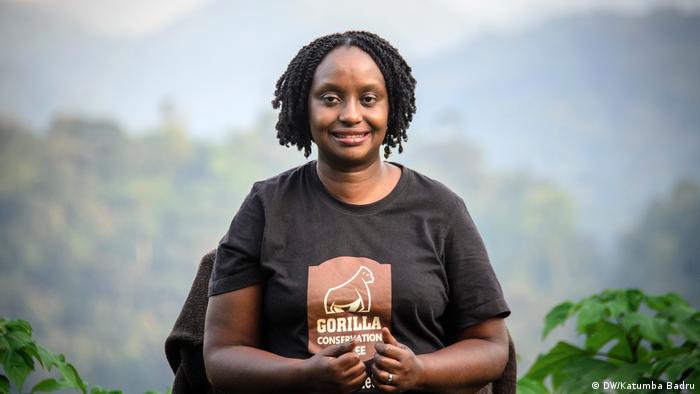 Veterinarian Gladys Kalema-Zikusoka realized that to protect gorillas, people had to be lifted out of poverty
Veterinarian Gladys Kalema-Zikusoka realized that to protect gorillas, people had to be lifted out of poverty
One farmer who fitted that profile was Safari Joseph. He began growing coffee in 2007 but like Byarugaba, for many years he didn’t make enough from it to live on. He got together with others in his community to find a solution. “Our challenge was that when we started coffee growing, our coffee had no market,” he says.
“That’s when we went to Dr. Gladys and convinced her to work with us and market our coffee.” She said yes, on the condition that they stop poaching. In 2015, Kalema-Zikusoka founded Gorilla Conservation Coffee.
Today, the brand supplies shops in Uganda, Kenya, New Zealand, Canada and the United States. It currently pays the equivalent of €0.31 ($0.34) for a kilo of red coffee cherries, almost twice the regular market price. The 500 farmers benefiting from these premium prices are members of the Bwindi Coffee Growers Cooperative, to which Joseph serves as secretary.
Musiimenta Allen, 32, oversees compliance for the cooperative, making sure its members adhere to practices that protect the forest. She is also one of two women on its committee — a position she uses to ensure the voice of female coffee farmers is heard.
Since her husband died in 2014, Allen has had to support herself and her two boys from her coffee plantation. She used to depend on the forest for daily essentials like firewood, but since joining the cooperative in 2016, she can afford to buy firewood instead.
Read more: Can renewable energy save Uganda’s Rwenzori glacier?
Struggling with cash flows and pests
Despite the gorilla logo that distinguishes Allen’s coffee on supermarket shelves, neighborly relations with the endangered primates aren’t always smooth. Occasionally, they invade her farm and destroy her crops. She also wishes Gorilla Conservation Coffee could provide its farmers with loans so they could increase production. “Sometimes I want to grow more coffee but I don’t have [enough] money,” Allen says.
And Joseph is concerned that Gorilla Conservation Coffee cannot always afford to buy all the coffee from its farmers, leaving them frustrated.
Kalema-Zikusoka concedes this is a problem. Gorilla Conservation Coffee relies on donor funding to buy coffee up-front and cut out the middlemen. But that means it doesn’t always have the cash to buy as much coffee as it could sell. “Because we don’t have enough money to buy coffee from the farmers, we aren’t able to fulfil the demand,” she says.
Byarugaba would also like to see the social enterprise provide more technical support. It teaches farmers better practices, but doesn’t provide experts to evaluate their farms. “Sometimes there are pests and diseases that we don’t understand, and the coffee trees get dry,” he says.
Read more: Africa’s Green parties bet on international help
An ethical choice over the thrill of the chase
And there’s something else about Byarugaba’s life as a farmer that leaves him wanting. He misses the old days, the thrill of the chase as his dogs gained on an antelope, the sound of hunting bells, and days trekking through a forest he rarely visits nowadays.
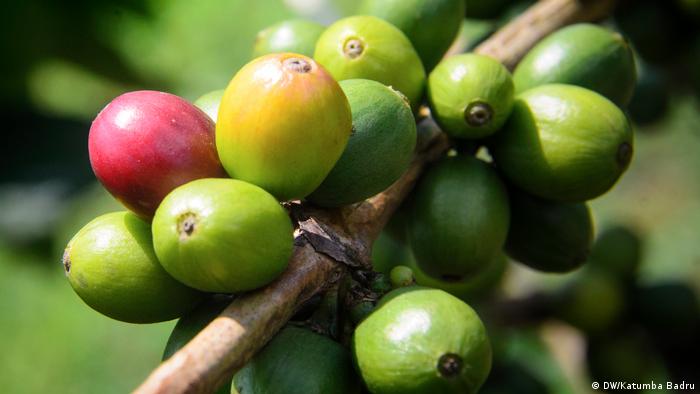 The ripening cherries of a Bwindi coffee plant. Commanding a premium price, the crop offers viable alternative to poaching
The ripening cherries of a Bwindi coffee plant. Commanding a premium price, the crop offers viable alternative to poaching
“I like poaching, most of the things I enjoyed in my life was poaching,” Byarugaba says, looking out over Bwindi Impenetrable Forest and breaking into a chuckle. Yet, on balance, he says it’s worth the sacrifice: “With coffee farming, I can always be assured of school fees for my children.”
Bwindi’s gorilla population has now grown from fewer than 300 in 1995 to over 400 . So, as well as paying a decent living, Byarugaba feels his decision has contributed to a greater good.
“In past years, I regretted [my decision] because we could get much from the forest,” he says. “Then I started earning some money and I don’t regret anymore: this life is better than the first.”
Author: Caleb Okereke-DW.COM
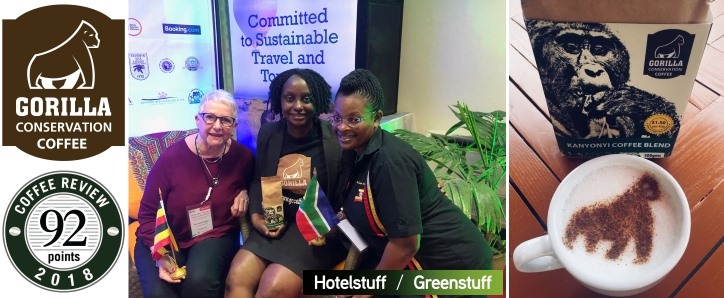
Lorraine Jenks met Dr. Gladys Kalema-Zikusoka and Lawrence Zikusoka at a Sustainable Travel summit in Kenya last week and was blown away by their work. Gorilla Conservation Coffee stands for everything we believe in. It ticks every conservation, sustainability and greening box possible. Coffee farmers were identified as being some of the poachers, so in helping them grow top quality coffee and find good markets; the previous poachers are now the guardians of the mountain gorillas. Is that not a wonderful story?
Gorilla Conservation Coffee is 100% premium Arabica that is selectively harvested from only red ripe cherries, hand picked, wet processed and dried under shade. The coffee is tested for quality parameters at every level. It is roasted medium and packed to the highest quality standards. Each cup has a unique aroma with hints of caramel, butter notes and almond, with a citrus taste and a sweet finish.
The team at Hotelstuff and Greenstuff would really like to help promote this product so that it becomes an example for other conservationists to emulate.
www.hotelstuff.co.za/suppliers/entry/gorilla-conservation-coffee